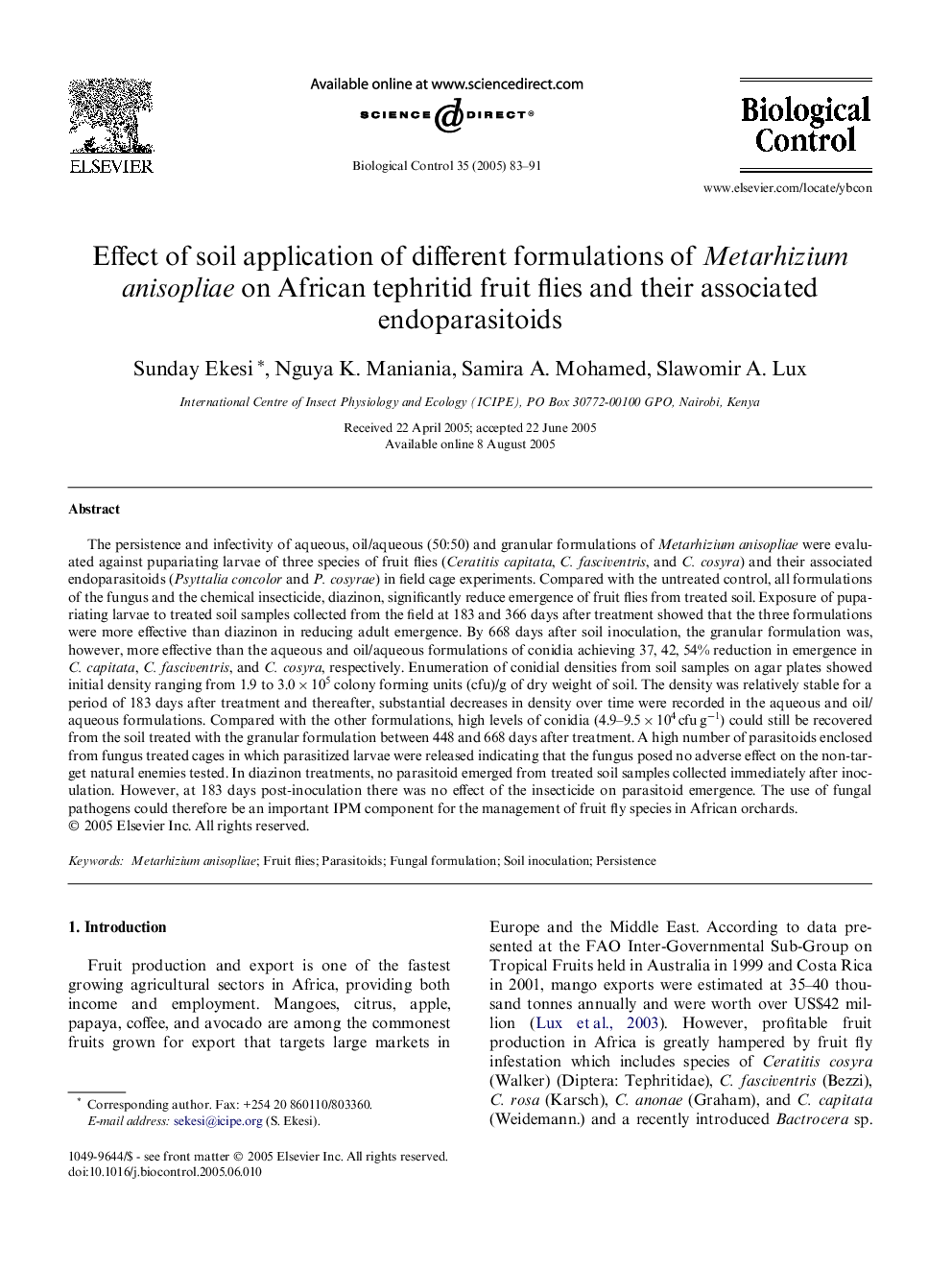| کد مقاله | کد نشریه | سال انتشار | مقاله انگلیسی | نسخه تمام متن |
|---|---|---|---|---|
| 9471920 | 1321145 | 2005 | 9 صفحه PDF | دانلود رایگان |
عنوان انگلیسی مقاله ISI
Effect of soil application of different formulations of Metarhizium anisopliae on African tephritid fruit flies and their associated endoparasitoids
دانلود مقاله + سفارش ترجمه
دانلود مقاله ISI انگلیسی
رایگان برای ایرانیان
کلمات کلیدی
موضوعات مرتبط
علوم زیستی و بیوفناوری
علوم کشاورزی و بیولوژیک
علوم زراعت و اصلاح نباتات
پیش نمایش صفحه اول مقاله

چکیده انگلیسی
The persistence and infectivity of aqueous, oil/aqueous (50:50) and granular formulations of Metarhizium anisopliae were evaluated against pupariating larvae of three species of fruit flies (Ceratitis capitata, C. fasciventris, and C. cosyra) and their associated endoparasitoids (Psyttalia concolor and P. cosyrae) in field cage experiments. Compared with the untreated control, all formulations of the fungus and the chemical insecticide, diazinon, significantly reduce emergence of fruit flies from treated soil. Exposure of pupariating larvae to treated soil samples collected from the field at 183 and 366 days after treatment showed that the three formulations were more effective than diazinon in reducing adult emergence. By 668 days after soil inoculation, the granular formulation was, however, more effective than the aqueous and oil/aqueous formulations of conidia achieving 37, 42, 54% reduction in emergence in C. capitata, C. fasciventris, and C. cosyra, respectively. Enumeration of conidial densities from soil samples on agar plates showed initial density ranging from 1.9 to 3.0 Ã 105 colony forming units (cfu)/g of dry weight of soil. The density was relatively stable for a period of 183 days after treatment and thereafter, substantial decreases in density over time were recorded in the aqueous and oil/aqueous formulations. Compared with the other formulations, high levels of conidia (4.9-9.5 Ã 104 cfu gâ1) could still be recovered from the soil treated with the granular formulation between 448 and 668 days after treatment. A high number of parasitoids enclosed from fungus treated cages in which parasitized larvae were released indicating that the fungus posed no adverse effect on the non-target natural enemies tested. In diazinon treatments, no parasitoid emerged from treated soil samples collected immediately after inoculation. However, at 183 days post-inoculation there was no effect of the insecticide on parasitoid emergence. The use of fungal pathogens could therefore be an important IPM component for the management of fruit fly species in African orchards.
ناشر
Database: Elsevier - ScienceDirect (ساینس دایرکت)
Journal: Biological Control - Volume 35, Issue 1, October 2005, Pages 83-91
Journal: Biological Control - Volume 35, Issue 1, October 2005, Pages 83-91
نویسندگان
Sunday Ekesi, Nguya K. Maniania, Samira A. Mohamed, Slawomir A. Lux,